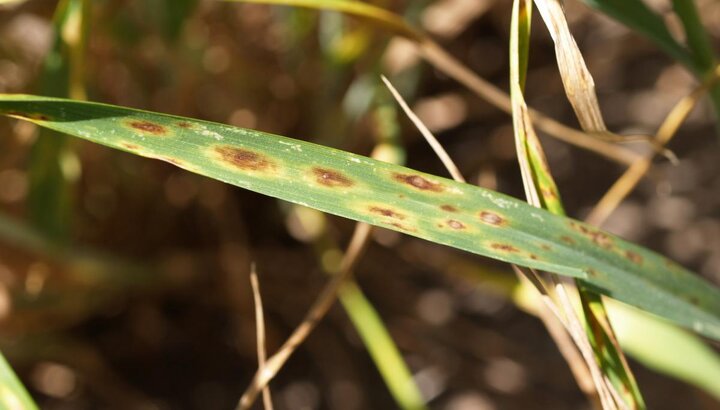Virus Diseases — Wheat streak mosaic virus / Triticum mosaic virus / High Plains virus / Wheat soilborne mosaic virus (Figure 1 )
Risk Factors
- Pre-harvest volunteer wheat in wheat fields where there was pre-harvest hail
- Pre-harvest volunteer wheat in summer crops such as sunflower
- Grassy weeds, for example, barnyard grass, green foxtail
- Prolonged warm fall/mild winter
- Early planting
- Planting wheat next to late maturing mite-virus hosts, for example, corn or foxtail millet
- Planting into low, poorly drained ground (wheat soilborne mosaic)

Management
- Control pre-harvest volunteer wheat in wheat fields and summer crops
- Control post-harvest volunteer wheat
- Control grassy weeds
- Avoid planting wheat too early
- Avoid planting wheat next to late maturing mite-virus hosts such as corn and foxtail millet
- Avoid planting wheat in low, poorly drained fields or areas
- Plant resistant/tolerant varieties if available and adapted to local conditions; most varieties are susceptible. See the Nebraska Fall Seed Guide and the K-State Wheat Variety Disease & Insect Ratings.
- Plant high risk fields last, for example. fields adjacent to grassy weeds and late maturing corn or foxtail millet
Stripe Rust (Figure 2 )
Risk Factors
- High inoculum load in southern states
- Overwintering caused by a prolonged warm fall followed by a mild winter
- Grassy weed hosts
- Cool, wet spring
Management
- Plant resistant varieties. See the Nebraska Fall Seed Guide, the K-State Wheat Variety Disease & Insect Ratings, and these CropWatch articles: Fall Strategies for Managing Wheat Diseases and 2017 Stripe Rust Ratings from Eastern Nebraska Wheat Variety Trials.

- Avoid planting wheat too early in the fall
- Scout wheat fields starting early in the spring
- Apply a fungicide in the spring; in a high risk situation – for example, stripe rust is detected early in the spring and there is a wet, cool spring – two sprays may be needed, one in early spring and a second one to protect the flag leaf. If only one spray is possible due to economics, the flag leaf spray is recommended
- Do not spray for stripe rust in the fall; if you are unsure, have a UNL extension specialist look at your field before you take any management measure in the fall.
Fungal Leaf Spots — Tan spot, Septoria, spot blotch (Figure 3 )
Risk Factors
- Wheat drilled into wheat stubble
- Wet spring
Management
- Crop rotation. Avoid drilling wheat into wheat stubble.
- Scout wheat fields starting early in the spring.
- Apply a fungicide in the spring; in a high risk situation – wheat drilled into wheat stubble and a wet spring – two sprays may be needed, one in early spring and a second one to protect the flag leaf. If only one spray is possible due to economics, the flag leaf spray is recommended.
- Plant resistant/tolerant varieties if available and adapted to local conditions; most varieties are susceptible. See the Nebraska Fall Seed Guide and the K-State Wheat Variety Disease & Insect Ratings.

Fusarium Head Blight (FHB, scab, Figure 4)
Risk Factors
- Planting into corn, wheat or sorghum stubble
- No-till or reduced tillage
- Background spore inoculum in the atmosphere
- Excessive and continuous rainfall before and during flowering
- Irrigation
- Moderate to warm spring temperatures
- Susceptible cultivars
Management
- Plant resistant/tolerant cultivars. See fusarium head blight ratings in CropWatch (Fall Strategies for Managing Wheat Diseases), and the K-State Wheat Variety Disease & Insect Ratings.
- Plant several cultivars with different flowering dates.
- Rotate wheat with non-host crops such as soybean or other broad leaf crops.
- Avoid planting wheat after corn, wheat, or sorghum.
- Manage irrigation in the spring and summer.
- Apply a fungicide at flowering.

Seed-transmitted and soilborne fungal diseases — Common bunt, loose smut, flag smut, ergot, root and crown rot diseases (Figures 5 and 6)
Risk Factors
- Planting bin-run seed – common bunt, loose smut, flag smut, ergot
- Planting wheat after wheat
- Planting wheat after grasses, for example, in ground that was under CRP
- Planting in a poorly prepared seedbed
- Planting in soil with insufficient or excessive moisture
- Planting at an improper depth


Management
- Plant certified, fungicide-treated seed. Certified seed is variety-pure and free of contamination with weed seeds and pathogen propagules as ergot sclerotia. Fungicide seed treatment ensures microscopic fungal spores and mycelia are killed, which prevents infection during or after germination.
- Avoid planting wheat after wheat or after CRP.
- Plant in a well prepared, firm, mellow seedbed.
- Avoid planting too shallow, too deep, or in soil with insufficient or excessive moisture.
Integrated Wheat Disease Management
The most effective strategy for managing wheat diseases is to combine as many management tactics as practical into an integrated disease management program. These tactics are:
- Scouting and disease identification
- Variety selection
- Cultural practices
- Crop rotation
- Tillage and residue management
- Planting date
- Nutrient management
- Irrigation management
- Control of volunteer cereals and weeds
- Chemical control
- Biological control
- Use of disease forecasting systems when available
Resources
For more information on managing diseases in wheat, view these Nebraska Extension resources:
- Managing Wheat Streak Mosaic (EC1871)
- Distinguishing Between Head Disorders of Wheat (EC1872)
- Ergot of Small Grain Cereals and Grasses and its Health Effects on Humans and Livestock (EC1880)
- Fusarium Head Blight of Wheat (EC1896)
Also see:
Wegulo, Stephen N. Integrated wheat disease management. Pages 417-441 in: Achieving sustainable cultivation of wheat Vol. 1: Breeding, quality traits, pests and diseases. 2017. P. Langridge (Ed.). Burleigh Dodds Science Publishing, Cambridge, UK.

